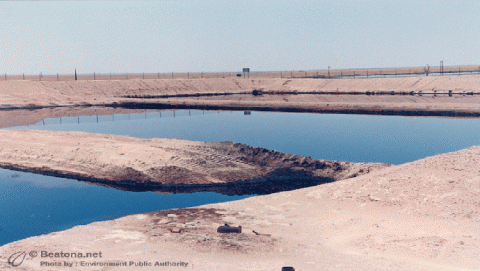Oil Lakes and Contaminated Soil in Kuwait
Over 114 km2 of Kuwait's desert were damaged by crude oil released when retreating Iraqi troops detonated 798 oil wells in Kuwait. Crude oil (mixed with the formation waters [over 10% salt] and over 6 billion gallons of seawater [4% salt content] used to extinguish the burning oil wells) flowed from the damaged wells and accumulated in depressions in the desert areas, contaminating over 40 million m3 of soil. This flowing oil mixed with billions of gallons of seawater created contaminated areas so large they were named oil lakes. Contamination of the desert altered soil properties, caused extensive plant and animal mortality, seeped into the soil layers where it reached the only fresh water aquifers in northern Kuwait and continues to impair ecosystem functioning.
The subsequent evaporation of lighter oil fractions, due to the extreme heat (soil temperatures may be as high as 86oC in the open desert during the hot summers months), resulted in the formation of a thick sludge consisting of heterogeneous layers of airborne dust laden, highly weathered crude oil, water, and oil/water emulsions with an underlying layer of contaminated soil; all impacted by residual salts from saline production water and seawater.
Oil Lakes and Oil Trench Related Contamination
Several studies have been done as part of Kuwait`s Monitoring and Assessment program to characterize the nature of these various forms of contamination. These forms of contamination are briefly described in the following paragraphs. Visible oil contamination in the terrestrial environment related to oil lakes and oil trenches has been identified in the following types:
- Wet Oil Lake Contamination
Today, wet oil lake contamination consists of black, highly weathered and viscous liquid or semi-solid oil sludge over a thickness of oil-contaminated soil that in turn overlies soil with no visible oil contamination. Wet oil lake contamination occurs in areas where free flowing crude oil accumulated because of micro relief and local topography. Such places include shallow depressions and drainage channels. Ponded oil remains and continues to infiltrate the underlying soils. The weathered oil may have a thin hardened layer on the surface, but this surface is not strong enough to support a person walking on it. Sludge material has been found to contain mean total petroleum hydrocarbon concentrations in excess of 19 percent. Underlying contaminated soil was found to contain a mean 3.4 percent total petroleum hydrocarbons. Aliphatic hydrocarbon profile data suggest petroleum hydrocarbons are dominated by hydrocarbons with chain lengths between C20 and C34. The presence of viscous petroleum has precluded completion of ordnance clearance in the areas where this type of contamination occurs. This type of material also presents distinct materials handling issues for remediation.
- Dry Oil Lake Contamination
Dry oil lake contamination is comprised of a black, moderately hard, tar-like dry surface layer (that may contain some contaminated soil material) overlying dark brown oil contaminated soil that in turn overlies soil with no visible oil contamination. Dry oil lake contamination occurs in shallow depressions and flat areas, often fringing areas of wet oil lake contamination. The surface tar-like material in areas of dry oil contamination was found to contain mean total petroleum hydrocarbon concentrations of about 7.3 percent. Underlying colored contaminated soil was found to contain a mean 2.5 percent total petroleum hydrocarbons. The aliphatic hydrocarbon data from samples of the upper tar-like materials, suggests a generally similar hydrocarbon distribution as the sludge.
- Oil-Contaminated Piles
Oil-contaminated piles occur where earth moving equipment has been used to consolidate oil-contaminated soil and/or liquid oil into mounds. These piles were made in efforts to stop the spread of oil flows caused by the destruction of the State of Kuwait’s oil wells, or to clear areas of heavy oil contamination as necessary to facilitate fire-fighting or subsequent Kuwait Oil Company (KOC) field operations. Even today, when disturbed, fluid oil may ooze from these piles. Oil contaminated pile materials were found to contain a mean total petroleum hydrocarbon concentration of about 4.4 percent.
- Oil Trenches and Associated Oil Spills
Today this material consists primarily of oil-contaminated soil from back-filled trenches. During Iraq’s invasion and occupation of Kuwait, Iraqi troops excavated oil trenches, mainly along the southern border zone of Kuwait 10 to 15 kilometers from and parallel to the northern Saudi Arabian border. The oil trenches were filled with crude oil piped from the oil fields through a network of Iraqi-constructed pipelines. After the liberation of Kuwait, some of the liquid oil was recovered from the trenches; and the trenches then backfilled during the period from 1993 to 1994. Included in this category are oil-contaminated soils associated with oil spills from the Iraqi-constructed oil pipelines. Total petroleum hydrocarbon concentrations in trench fill soils varied between 1,080 mg/kg and 140,000 mg/kg. Concentrations in spill areas varied between 6,040 mg/kg and 117,000 mg/kg. Oil trench contamination was found to extend deep into underlying gatch soils. The depth of contamination within trench areas was found to vary between 0.9 and 7 meters.
In general, the soils/sludge tested are characterized as follows:
- In place density of about 1.7 grams per cubic centimeter.
- Heat value averaging about 650 British thermal units for contaminated soil and 7,550 British thermal units for sludge material.
- Soils are extremely hydrophobic with water drop penetration tests as high as 19,000 seconds.
- Oil-contaminated soil pH averages 7.7 pH units. Oily sludge pH averages 6.7 pH units.
- Soil moisture content averages about 2.4 percent. Sludge moisture content averages about 28 percent.
- Significant concentrations of asphaltenes were found averaging 6.5 percent in contaminated soil samples and averaging 28 percent in sludge material, in comparison to 3 percent in Kuwaiti crude oil.
- Although not systematically measured, the salt content of the soil is generally greater than 10%.
- Soils were found to have low concentrations of nitrogen and phosphorus.
- Soil samples were found to contain several bacteria commonly associated with hydrocarbon contaminated soil. However, populations of bacteria capable of using Kuwait crude oil as sole carbon source were considered low.
Volume of Oil Lake and Trench Contamination (( Volume is millions of cubic meters ))
|
Matrix |
Average Depth (centimeters) |
Extent (square kilometers) |
Volume (cubic meters x106) |
|
Dry oil lakes |
25 |
98.38 |
24.5 |
|
Wet oil lakes |
64 |
7.19 |
4.6 |
|
Oil contaminated piles |
173 |
8.59 |
14.8 |
|
Oil trenches and pipeline spills |
351 |
1.63 |
5.7 |
|
Total |
115.79 |
49.6 |
In the above volume estimates, approximately 3.4 million cubic meters of contaminated gatch is included in the oil trench related contamination. In addition, not included in the estimates of the area of contamination is physical damage to the soil, protective surface crust and vegetation covering an additional 15 square kilometers in areas adjacent to pipelines resulting from their construction. Although petroleum contamination is not reported in these areas, the physical disturbance constitutes another form of damage.
A major obstacle in fully assessing oil-lake beds has been the presence of unexploded ordnance (UXO). The complex content of oil lakes (oil mixed with seawater, sand and debris), and their variable depth (1.5 m up to 6 m) will complicate the remediation program and add new technical challenges associated with UXO detection. The significant challenge is finding the best techniques for detecting and identifying ordnance for this unique situation. This sort of UXO location process has never been undertaken before. Once detected, safe removal and disposal will require expert support; and the cooperation of Kuwait’s Ministry of Defence. At present all the oil lakes can be considered suspect hazardous areas (SHAs) where a threat is believed to exist but neither its magnitude nor its location are defined.









